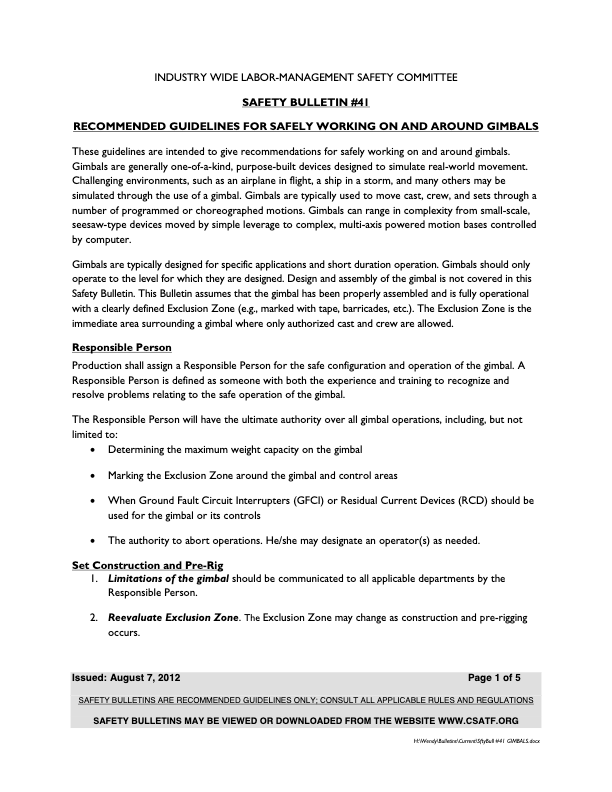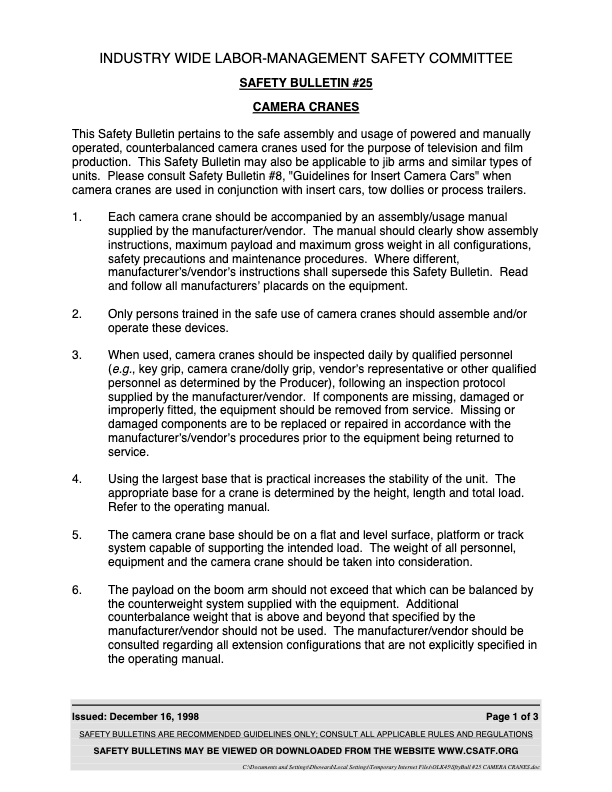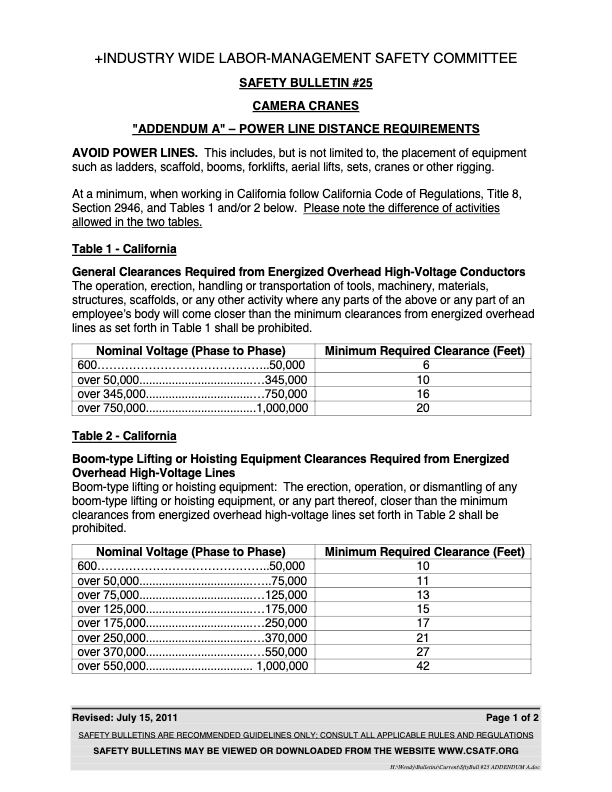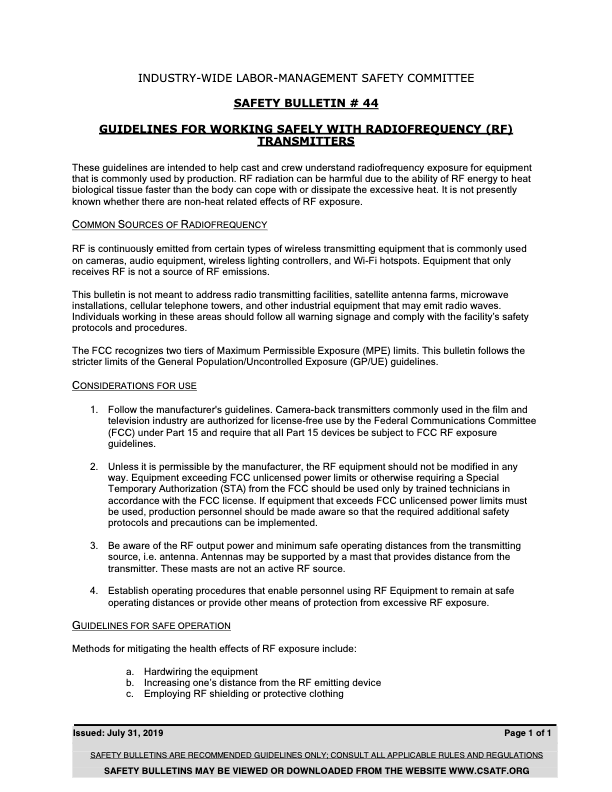Safety Bulletin

Guidelines
These guidelines are intended to give recommendations for safely working on and around gimbals. Gimbals are generally one-of-a-kind, purpose-built devices designed to simulate real-world movement. Challenging environments, such as an airplane in flight, a ship in a storm, and many others may be simulated through the use of a gimbal. Gimbals are typically used to move cast, crew, and sets through a number of programmed or choreographed motions. Gimbals can range in complexity from small-scale, seesaw-type devices moved by simple leverage to complex, multi-axis powered motion bases controlled by computer.
Gimbals are typically designed for specific applications and short duration operation. Gimbals should only operate to the level for which they are designed. Design and assembly of the gimbal is not covered in this Safety Bulletin. This Bulletin assumes that the gimbal has been properly assembled and is fully operational with a clearly defined Exclusion Zone (e.g., marked with tape, barricades, etc.). The Exclusion Zone is the immediate area surrounding a gimbal where only authorized cast and crew are allowed.
Responsible Person
Production shall assign a Responsible Person for the safe configuration and operation of the gimbal. A Responsible Person is defined as someone with both the experience and training to recognize and resolve problems relating to the safe operation of the gimbal.
The Responsible Person will have the ultimate authority over all gimbal operations, including, but not limited to:
- Determining the maximum weight capacity on the gimbal
- Marking the Exclusion Zone around the gimbal and control areas
- When Ground Fault Circuit Interrupters (GFCI) or Residual Current Devices (RCD) should be used for the gimbal or its controls
- The authority to abort operations. They may designate an operator(s) as needed.
Set Construction and Pre-Rig
- Limitations of the gimbal should be communicated to all applicable departments by the Responsible Person.
- Reevaluate Exclusion Zone. The Exclusion Zone may change as construction and pre-rigging occurs.
- Establish work procedures (e.g., lockout/tagout/blockout, fall protection, guardrails, etc.) and other special procedures for working on or around the gimbal.
- Establish emergency shutdown procedures. The dynamic action of the gimbal may create an additional hazard to personnel working on or around the gimbal if it is suddenly shutdown. Personnel on or around the gimbal may have to take specific action to protect themselves in the case of an emergency shutdown.
- The Responsible Person should be consulted before operating heavy equipment (e.g., aerial lifts, camera cranes, forklifts, etc.) around the gimbal, hydraulic lines, and/or control lines.
- When necessary, crib or block to prevent parts from moving inadvertently when the gimbal is not in operation.
- Ensure crossovers and/or protective covers are used to protect hoses, electrical cables, and control lines and to prevent possible tripping hazards.
Safety Meetings During Construction and Pre-Rig
Make crew and applicable department heads aware of the designated Responsible Person, Exclusion Zone parameters, gimbal limitations, work procedures, emergency procedures, and individuals authorized to be inside the Exclusion Zone.
All items included in Set Construction and Pre-Rig should be reevaluated throughout the production as conditions change.
Inspection and Testing
Representatives from all applicable departments shall be included in conducting inspections of their equipment on or around the gimbal, prior to operation.
The Responsible Person should:
- Reevaluate the limitations of the gimbal such as, but not limited to, load capacity, how it may be affected by water, weather, additional equipment, structures, dust effects, etc.
- Inspect gimbal, base, hoses, structure, service connections to equipment on the gimbal (e.g., electrical special effects), etc.
- Test controls.
- Evaluate potential impact on cast and crew within the intended load and range of movement.
- Prior to operation, verify the Exclusion Zone is free of any unauthorized persons or items.
- Check for electrical and/or radio and wireless interference, and maintain the proper perimeter around the gimbal and computer controls.
Prior to Rehearsal and Filming
Reevaluate the Exclusion Zone and communicate to all cast and crew (size and operation of the gimbal will dictate).
Please follow Inspection and Testing items 1–6 above.
Inspect and test other production-related equipment on or around the gimbal.
Safety Meeting
The First Assistant Director shall, along with the Responsible Person, conduct a safety meeting with all cast and crew, including, when necessary, a stunt coordinator, prior to working on or around the gimbal.
Safety meeting topics may include, but are not limited to:
- Communicating to all involved personnel, including performers, the intended action, full range of movement, need for increased awareness, possible changes, and authority to abort, including any visual or audio signals to be used.
- Authorized personnel riding the gimbal should consider their health status and report any concerns to the appropriate person.
- The possible effects of electrical or radio and wireless devices on radio-sensitive equipment.
- Awaiting Responsible Person to give permission before approaching the gimbal.
- The perimeter of the Exclusion Zone.
- Emergency Shutdown Procedures.
The Responsible Person should be notified of any changes or concerns in the use of the gimbal, action of the cast or crew, or placement of equipment in order to determine whether an additional safety meeting is necessary.
Ongoing Testing
The Responsible Person or his/her designee shall conduct a test of all controls at least prior to the gimbal being used during each work shift and upon returning to the gimbal from breaks.
During Operation
- Follow established procedures when entering the Exclusion Zone.
- Gimbal Operator needs a clear line of sight or, if needed, a spotter to assist.
- Gimbal Operator should be at the controls at all times when the gimbal is operational.
- Gimbal should be stopped if unauthorized personnel enter the Exclusion Zone.
- Watch for loose materials, sharp edges, pinch points, etc.
- Authorized cast and crew should be made aware of the capabilities and anticipated movement of the gimbal.
- Ensure clear, safe access and egress.
- Maintain reliable communications during operation.
- Always wait for the Responsible Person to give permission before approaching the gimbal.
- Secure set pieces, production equipment, and props on the gimbal.
- On computer controlled gimbals, ensure the computer has an uninterrupted power supply to allow reliable operation and shutdown in the event of a power interruption.
Additional Considerations
Production Management and the Responsible Person shall take the following into consideration and address with the appropriate personnel:
- Fall protection for cast and crew; for example, barriers, guard rails, pads, or fall restraint equipment including appropriate anchor points
- All electrical distribution system components exposed to water should be designed to work in water
- Galvanic action, which is corrosion from contact between dissimilar metals
- Inspection of underwater equipment
- Windy conditions
- Environmental and human factors
- Hydraulic leaks
- Inclement weather
- Access to the gimbal by cast and crew
- Placement of electrical equipment and power supply system
- Lockout/Tagout/Blockout






